The importance of fastening your skates efficiently
Quality of skating and power are key factors for performance in skating. But just as would say a famous pneumatic brand: “Power is nothing without control”. That’s why a good fastening is also determining. Tips and explanations…
Par alfathor
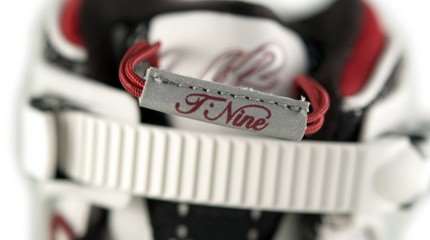
3 great concepts combined for more efficiency
What’s the use of fastening?
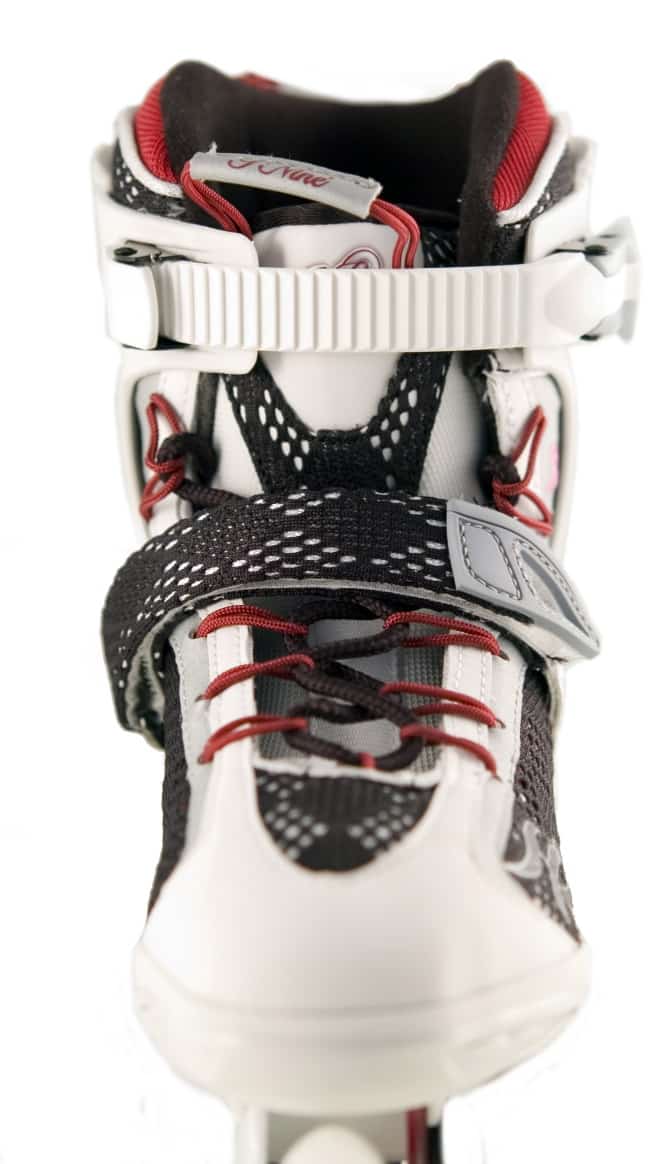
You border on truism with such a question! Fastening enables to optimize the cohesion between the boot of your skate and your foot. The more precise the fastening, the less loose your foot will be… provided that the size fits you.
An efficient fastening combined to a skate boot close to your foot provides:
- More precision in your moves
- A better reactivity
- A better transmission of your energy to the skate during the push
- Easier to handle
There are 3 main types of fastening systems for your skates and numerous versions:
- Micrometric buckles
- Laces
- Velcros
Then, each manufacturer patents the numerous versions of these concepts. Let’s remember for example the BOA system for K2 or the ATOP II concept for Powerslide: knob systems, that you have to dial in order to tighten the laces. Back then, Salomon also proposed the Quicklace which you can still find today on some shoes of the brand from Annecy.
Tip: You often recognize a good pair of skates thanks to the fact that even when all the fastening systems are loose, the skates still ensure good support for your foot.
Micrometric buckles
They would have been used for the first time on skate boots at the end of the 80s by Rollerblade. Micrometric buckles are notched straps, like rack rails.
Their length is adjustable thanks to the stop system swallowing the strap notch by notch.
It’s the most commonly used system since the renewal of inline skates. Their process is the same as that of a ski boot. And it is probably the most efficient system.
There are lots of different micrometric buckles on the market:
- Roces created a system enabling to always have the same fastening thanks to a memory buckle
- Speed skating micrometric buckles can come loose all at once or progressively thank to two little lugs on the sides of the notched strap
- Seba proposes micrometric buckles with a system avoiding that the buckle unlocks during use thanks to the Safety Lock.
- And many other concepts…
 |
Pluses+ Precision of fastening |
 |
Minuses– Risks of pressure points if the buckle is not wide or padded enough |
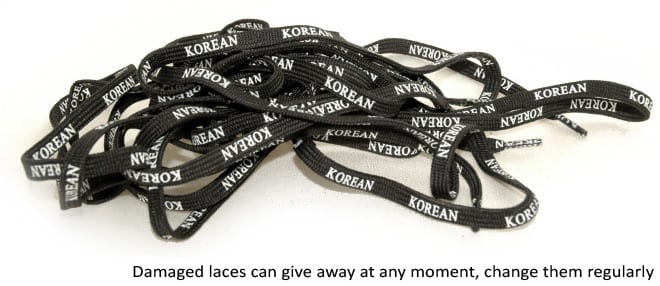
Laces
They’ve equipped shoes for hundreds of years, and finding them on skate boots is pretty logical! According to the skating practice under consideration, they may be the first or the second fastening system most commonly used.
On artistic and hockey skates for example, you’ll find only laces! They literally wrap up the whole foot, from the toes to the shin. In these specialties, it is very important to take your time to lace your boots up.
This fastening process is also present in most of the other disciplines, but it is combined with other systems. In Speed skating, Downhill, Street skating, Slalom skating, Freeskating, they are very often completed with micrometric buckles or velcros.
Today there are numerous processes to improve your lacing: self-locking laces, Quicklace systems, etc.
How to lace up your boots efficiently?
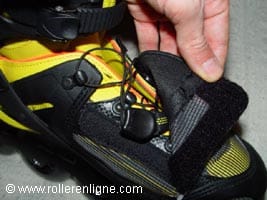 In order for your lacing to be efficient, you should always start by the toes. Start with fastening the down part and go upwards. It is important to slide the laces eyelet by eyelet for them not to loosen up afterwards. Ban supple and elastic laces for skating, they lack precision.
In order for your lacing to be efficient, you should always start by the toes. Start with fastening the down part and go upwards. It is important to slide the laces eyelet by eyelet for them not to loosen up afterwards. Ban supple and elastic laces for skating, they lack precision.
If your laces are too stiff, you can coat them with wax to make them suppler and ease the sliding in the eyelets.
Once finished, the lacing should be homogeneous, and you should not feel any pressure point. If you do, loosen the incriminated area.
Another important point: When a pair of skates is equipped with multiple fastening systems, always start with the lacing!
Tip: Speed skaters often use 2 laces on the same boot to refine their fastening for the down and up parts of the foot. This also works for the other disciplines!
 |
Pluses+ A good fastening precision |
 |
Minuses– Classic lacing often takes a long time |
Velcros
Velcros are often used as complementary fastening systems.
The word “Velcro” became part of our everyday language, but let’s not forget that it is a registered trademark, just like Hoover is used for vacuum cleaner and Rollerblade for rollerskate. It was invented in 1948 and patented in 1951.
Velcros are particularly used on straps in order to maintain the ankle at the bottom of the boot or to adjust the fastening on the top of the foot, for example with Speed skating boots.
They are good fastening supplements, but they are not enough to ensure an efficient fastening alone.
 |
Pluses+ An interesting fastening adjustment |
 |
Minuses– Self-gripping straps are often too supple |
Fastening combinations
You can combine these fastening processes in order to obtain an optimum support… and the big brands didn’t hesitate to innovate all through the years! The table below sums up the systems used according to the different practices. The recommended systems are in bold.
Here is a summary table of the most commonly used systems according to practices…
| Discipline | fastening on the toes |
fastening on the top of the foot |
fastening on the shin |
| Street skating / Fitness |
|
|
|
| Aggressive/Ramps/Parks |
|
|
|
| Speed-skating |
|
|
– |
| Roller-hockey |
|
|
|
| Artistic skating |
|
|
|
| Downhill |
|
|
|
| Rink-hockey |
|
|
– |
| Roller-derby |
|
|
– |
| Slalom |
|
|
|
| Freeskating |
|
|
|
Evolution of the fastening systems for skating in 15 years
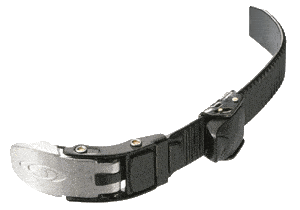 The proportion of laces has increased since 1997 while that of skates only equipped with micrometric buckles decreases.
The proportion of laces has increased since 1997 while that of skates only equipped with micrometric buckles decreases.
Nowadays, the most commonly used systems are the ones combining two concepts. They are generally made of lacing and Velcro strap. Their proportion increased of more than 20% in four years between 1997 and 2000.
In fact, according to the discipline in consideration, either one system or the other prevails.
From now on most of the time street, slalom or freeskate skates combine velcros, laces and micrometric buckles. If you happen to make a customized set-up for one of these disciplines, better use micrometric buckles on the top of the foot and the shin!
Useful links
The manufacturing of a pair of skates
Make me a skatepark
The manufacturing of frames made of composite
How are manufactured skate wheels?
The manufacturing processes of skate frames
How are manufactured skate bearings?
The manufacturing secrets of skate boots
Anatomy of a rink hockey boot
Speed skating: the era of custom-made skates?
Translated by Chloé Seyres
Photos : Alfathor and
Salomon


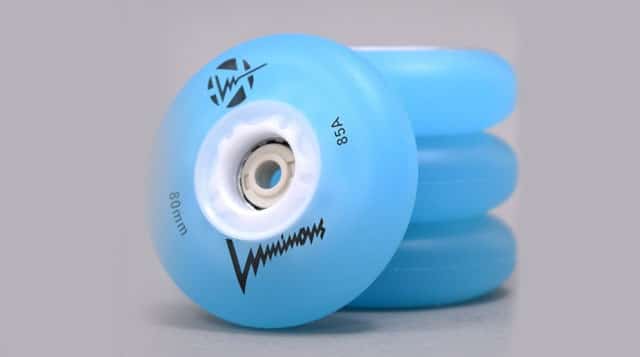
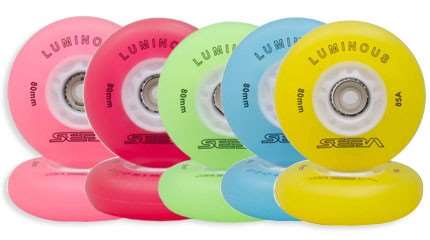
Paul
4 août 2012 at 20 h 42 minAlfathor
4 août 2012 at 11 h 34 min